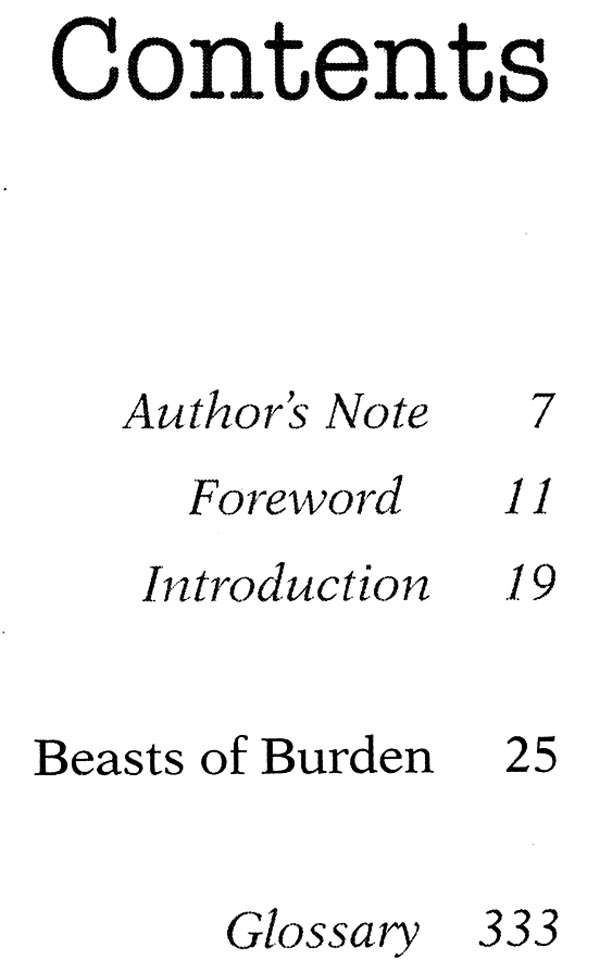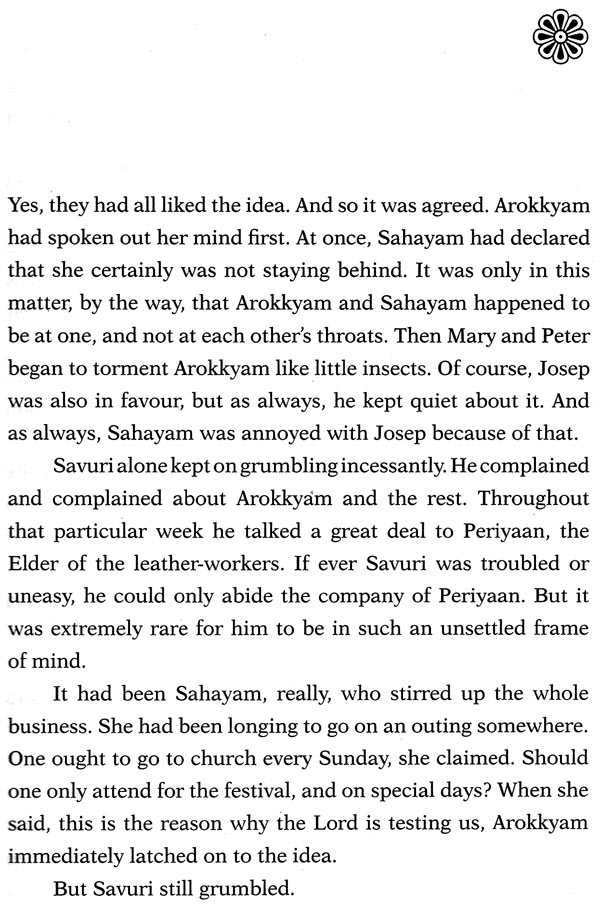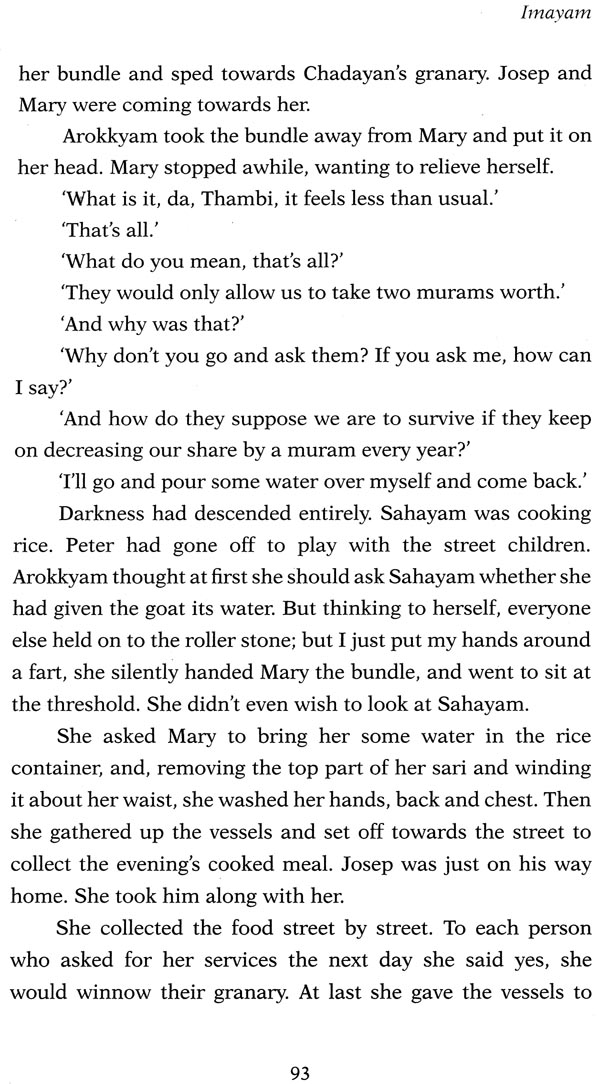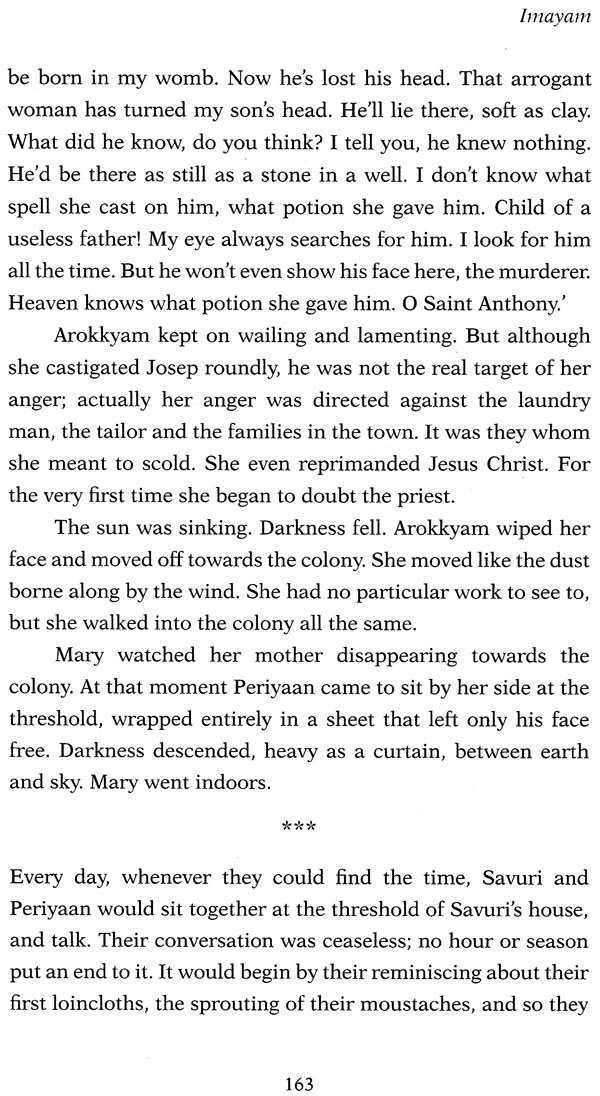
Beasts of Burden
Book Specification
| Item Code: | NAU192 |
| Author: | Imayam and Lakshmi Holmstrom, Mark Holmstrom, and Mini Krishnan |
| Publisher: | Niyogi Books |
| Language: | English |
| Edition: | 2019 |
| ISBN: | 9789386906625 |
| Pages: | 335 |
| Cover: | HARDCOVER |
| Other Details | 9.00 X 6.00 inch |
| Weight | 520 gm |
Book Description
The first novel of one of the best writers today, Beasts of Burden (Koveru Kazhuthaigal) is located in the early 1970s when ritual status and payment in kind were giving way to cash wages. It is a tapestry of despair, courage and a journey both outward and inward and a story of decline and change in a village seen through the eyes of a washerwoman (vannati) Arokkyam, who serves a dalit community of agricultural labourers. The 'mules' of the title refers ironically to the vannaan and vannaatti themselves who traditionally carried their washing on donkeys. Although they play an important role in all Hindu rites of passage, it is striking that Arokkyam and Savuri are Catholics. Most importantly, they defer to the authority of the priest at the Church of Saint Antony and seek his blessing on family and community occasions.The novel gives us an extraordinarily detailed picture of a lifestyle that has now passed: reclaimed and told with pride.
The worst oppression of the caste system, Imayam suggests, is that people are dependent upon it for their living.
Imayam
(the pen name of V Annamalai) is a prominent and well-known Indian novelist writing in Tamil. He wrote five novels, five short story collections and a novella.
Born in 1964 into a peasant family, Imayam had his college education at Periyar E.V.R. College. Tiruchirappalli. It was S. Albert, a Professor from Trichy who 'opened the door to the world' for him. His first novel Koveru Kazhuthaigal (Beasts of Burden) created heated debates on issues like the role of a Dalit writer in the context of oppression seen on Dalit community. The book won Imayam many awards, including Agni Akshara Award, Tamil Nadu Progressive Writers Forum Award (1994) and Amudhan Adigal Ilakkiya Award for Literature (1998). Among his other works, Arumugam (1999), Sedal (2006) and Pethavan (2012) are very well received
A secondary grade teacher in a school run by Adi Dravid Welfare Department at Pulichapallam, Imayam has been closely associated with the Dravidian Movement and its politics.
Lakshmi Holmstrom (1935-2016)
was an Indian-British writer, literary critic, and translator of Tamil fiction into English. Her most prominent works were her translations of short stories and novels of the contemporary writers in Tamil, such as Mowni, Pudhumaipithan, Ashokamitran, Sundara Ramaswamy, C.S. Lakshmi, Bama, and Imayam. She obtained her Bachelors degree in English Literature from the University of Madras and her postgraduate degree from University of Oxford. Her dissertation work was on the works of R.K. Narayan. She was the founder-trustee of SALIDAA (South Asian Diaspora Literature and Arts Archive) - an organisation for archiving the works of British writers and artists of South Asian origin. She was appointed Member of the Order of the British Empire (MBE) in the 2011 New Year Honours for services to literature.
Koveru Kazhuthaigal was published in 1994. It is the first novel of Imayam, a school teacher in South Arcot district, near Chennai. The title means 'mules', but carries the sense here of 'beasts of burden'. It has a particular significance because the story is that of a vannaan (washerman) family, who traditionally carried their bundles of washing either on donkeys or mules. The 'mules' of the title, though, refers ironically to the vannaan and vannaatti themselves.
The story is that of decline and change in the village, seen through the perspective of the vannaatti, Arokkyam, who serves a Dalit community of agricultural labourers, attached individually as bonded labourers to Gounder families. It is located in the early seventies, a time when ritual status and payment in kind were giving way to a contract based solely on cash wages.
Arokkyam and her husband Savuri serve only the dalit streets, always known as 'the colony', which also has its own lower caste priest; a separate washerman serves the upper caste village or uur. The harijan or dalit washerman is not even allowed into the houses of the other dalits he works for, and they pay him partly in cooked rice and leftovers every evening, and in grain, foodstuffs, clothes, etc., at other fixed times of the year.
Although they play an important role in all Hindu rites of passage, it is striking that Arokkyam and Savuri are Catholics. This means—besides personal devotion to Christ and to Saint Anthony—going to the Church of Saint Anthony as and when they can, particularly on Feast days. As the church is some distance from the village, and their services in the village are needed constantly, it is not often that they can find time to attend. Most importantly, they defer to the authority of the priest there, and seek his blessing at all Catholic Church services, and on important occasions like weddings.
Koveru Kazhuthaigal gives us an extraordinarily detailed picture of a lifestyle that has now passed; a lifestyle that is reclaimed and told with pride, without any attempt to ‘Sanskritize' it. That is, there is no supposition that the lifestyles of the upper castes (vegetarianism, brahminic rituals, etc.) are, or ought to be, the norm. Yet it is not even the rich ethnographic detail that makes the book so valuable, but the insight it gives us into the life of the woman, Arokkyam, literally in the margins of society (her house is outside the colony, while the colony itself is outside the caste village) and poised between Hindu ritual and Christian devotion. The names, incidentally, have a ringing poignancy: Arokkyam means 'good health', 'well-being'; Savuri is the Tamil version of Xavier.
The novel is constructed on two journeys: a pilgrimage of hope at the beginning; a routine trip to the washing pool in drudgery and despair at the end. Between these, it is signposted by rites of passage which give a sense of cyclical time, but also by landmarks of historial, linear time. This climate of time and change is important to the novel whose primary theme is Arokkyam's dilemma within changing systems of belief about the self and society. First, there is the gradual commercialization of traditionally caste-linked functions. The village acquires a regular tailor and a laundryman with a box-iron, both of whom serve not only the village people, but the colony dwellers too, taking away the custom from the traditional washerman. Changing styles of dress contribute to this too, as men begin to wear shirts and trousers that need pressing rather than the traditional veshti wrapped about the waist. Both Arokkyam's sons move into more liberated worlds: her elder son, Josep, is persuaded by his wife to leave home and go into partnership with his brother-in-law to start a laundry business in town, while the younger, Peter, cannot understand why they do not go in for coolie work that would be paid in daily cash wages. At the same time as this loss in main livelihood, there is a steady decline and breakdown in the old caste prerogatives: the amount of grain that Arokkyam and Savuri were allocated by right at each household where they winnowed, dwindles to no more than a single scant tray; the head and intestines of the sacrificial twat which was traditionally the vannaan's by right begins to be auctioned. And the payment for all ritual services grows less and less; is often no more than a token.
Arokkyam has one main hope in coping with change: that the church will intervene in support of the old order, and appeal to the elders of the colony to keep up their caste obligations to their vannaan. The novel begins with a pilgrimage to the Church of Saint Anthony, which is a journey of hope. In fact when the church intervenes much later, it is with an offer which is totally unexpected: to take the youngest son Peter away, and train him to become a priest. In a beautifully developed central chapter, Arokkyam struggles with the anguish of her choices. The novel turns on this central dilemma.
The indomitable but suffering mother figure is a repeated image in Marathi dalit writing. She is often the sole breadwinner, sacrificing everything for the family. Namdeo Dhasal, Vaman Nimbalkar and Jyoti Lanjeswar have all written poems entitled, `Mother'. Gail Omvedt in her article in Nirappirikai (Nov. 1994) points to the mother figure in the poetry of dalit men as a continuing symbol of oppression, and also of struggle, sacrifice and sense of duty. But she adds that in all such portraits, 'These women did not challenge nor change greatly the nature of the functions and duties that were traditionally theirs.' The portrait of Arokkyam is in that tradition, but at the same time different from the symbolic archetype. She is not described objectively, but from within; from the perspective of her own dilemma, within the terms of her own anguish.
Next year we are going to celebrate the 25th anniversary of Imayam's epoch-making novel, Koveru Kazhuthaigal. Imayam has now become a celebrated Tamil writer with three more novels. His short stories have appeared both in literary journals as well as in popular magazines, winning the attention of a wide range of readers. Niyogi's reprint of the English translation of Koveru Kazhuthaigal — Beasts of Burden — by the acclaimed translator, Lakshmi Holmstrom, is coming to us sixteen years after its first appearance in 2001. Notwithstanding Imayam's critical remarks on Dalit literature and his continual resistance to his works being read within the framework of Dalit literature, Koveru Kazhuthaigal has acquired a unique place in the history of Tamil Dalit literature.
Today we may find it easy to read Koveru Kazhuthaigal as a Dalit novel with the received knowledge of the Dalit uprising of the 1990s, of our acquaintance with a range of Dalit literature that have appeared in Indian languages and been made accessible through their English or vernacular translations. We may also like to locate the novel today within the dialectics of Dr. Ambedkar's 125th birth anniversary, the visibility of Dalit movements in the electoral politics and the renewed violence against Dalits as reported in the mainstream media. But Imayam's visibility among the Tamil readers does not have any direct link with these celebrations and debates. He has been continually challenging such attempts to invoke an ideology out of his fictional universe.
Imayam's stories represent the moments that go beyond our narrow understanding of social relations limited to caste. His stories continue to warn us against our desire for easy solutions and oppositions. Naturally, he is scorned by different circles with varied ideologies. While a few regard Koveru Kazhuthaigal as an anti-Dalit text for representing the function of caste among Dalits, some (especially the academic readers) like to read it simply as a Dalit text. For example, the abusive dialogues between characters — which are part of the narrative and are rooted in everyday situations — cannot be regarded as an attack on a particular social class nor can be classified as `dalit language'. However, those who seek diversity praise Imayam's ability to vouch for the truth of caste, not just Dalit oppression. He stands for love, but is read only as a Dalit writer who launches a protest against the dominant. This is similar to the reception of writers like Mahmoud Darwish, the Palestinian poet. The 'love' these writers try to represent is not just a humanistic one. It suggests the recognition of love that would serve as an answer to despair. For Imayam, caste, along with gender, is an institution that establishes a strict binary between love and hate, and one against which everyone should protest. Caste thus becomes a significant social factor that obstructs the language of love and destabilizes social well-being. It is this view on caste as the lack of love in human relations — that has secured him the status of a celebrity writer among the Tamil readers.
We may justify our reading of Imayam's fiction merely as Dalit fiction, citing his participation in the Dalit panel in regional, national and international conferences. But, we choose not to lend our ears to his vocal condemnation of any identity-based readings of literature and production of a literature guided by an ideology. During the post-90s, the autobiographical and testimonial narratives insist on the return of the author (against the notion of the death of the author). It is significant to note that Imayam (and a few other Tamil 'Dalit' writers) refuses to claim that identity and this demands our serious attention. The question is not just about their denial of identity but also about the need to respect their anonymity.
**Contents and Sample Pages**














